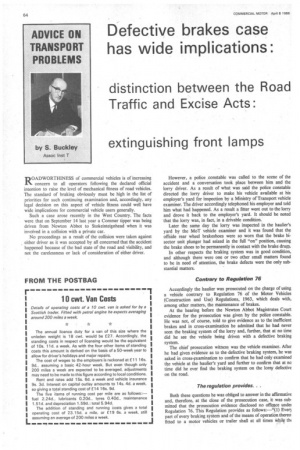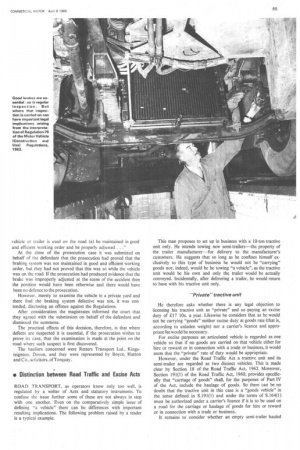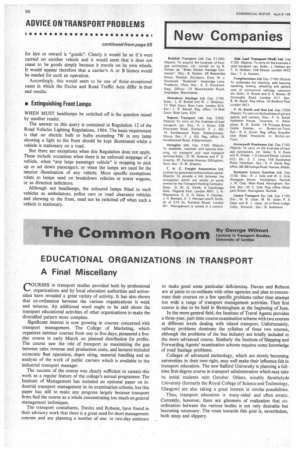Defective brakes case has wide implications:
Page 66

Page 67

Page 68

If you've noticed an error in this article please click here to report it so we can fix it.
distinction between the Road Traffic and Excise Acts: extinguishing front lamps
ROADWORTHINESS of commercial vehicles is of increasing concern to all operators following the declared official intention to raise the level of mechanical fitness of road vehicles. The standard of braking obviously must be high in the list of priorities for such continuing examination and, accordingly, any legal decision on this aspect of vehicle fitness could well have wide implications for commercial vehicle users generally.
Such a case arose recently in the West Country. The facts were that on September 14 last year a Commer tipper was being driven from Newton Abbot to Stokeinteignhead when it was involved in a collision with a private car.
No proceedings as a result of the collision were taken against either driver as it was accepted by all concerned that the accident happened because of the bad state of the road and visibility, and not the carelessness or lack of consideration of either driver.
However, a police ,constable was called to the scene of the accident and a conversation took place between him and the lorry driver. As a result of what was said the police constable directed the lorry driver to make his vehicle available at his employer's yard for inspection by a Ministry of Transport vehicle examiner. The driver accordingly telephoned his employer and told him what had happened. As a result a fitter went out to the lorry and drove it back to the employer's yard. It should be noted that the lorry was, in fact, in a drivable condition.
Later the same day the lorry was inspected in the haulier's yard by the MoT vehicle examiner and it was found that the offside rear wheel brakeshoes were so worn that the brake bisector unit plunger had seized in the full "on" position, causing the brake shoes to be permanently in contact with the brake drum.
In other respects the braking system was in good condition, and although there were one or two other small matters found to be in need of attention, the brake defects were the only substantial matters.
Contrary to Regulation 76 Accordingly the haulier was prosecuted on the charge of using a vehicle contrary to Regulation 76 of the Motor Vehicles (Construction and Use) Regulations, 1963, which deals with, among other matters, the maintenance of brakes.
At the hearing before the Newton Abbot Magistrates Court evidence for the prosecution was given by the police constable. He was not, of course, told to give evidence as to the inefficient brakes and in cross-examination he admitted that he had never seen the braking system of the lorry and, further, that at no time did he see the vehicle being driven with a defective braking system.
The chief prosecution witness was the vehicle examiner. After he had given evidence as to the-defective braking system, he was asked in cross-examination to confirm that he had only examined tile vehicle at the haulier's yard and further to confirm that at nc time did he ever find the braking system on the lorry defective on the road.
The regulation provides. . .
Both these questions he was obliged to answer in the affirmativ( and, therefore, at the close of the prosecution case, it was submitted that the prosecution evidence disclosed no offence undei Regulation 76. This Regulation provides as follows:—"(1) Ever3 part of every braking system and of the means of operation thereo fitted to a motor vehicles or trailer shall at all times while th( vehicle or trailer is used on the road (a) be maintained in good and efficient working order and be properly adjusted . ."
At the close of the prosecution case it was submitted on behalf of the defendant that the prosecution had proved that the braking system was not maintained in good and efficient working order, but they had not proved that this was so while the vehicle was on the road. If the prosecution had produced evidence that the brake was improperly adjusted at the scene of the accident then the position would have been otherwise and there would have been no defence to the prosecution.
However, merely to examine the vehicle in a private yard and there find the braking system defective was not, it was contended, disclosing an offence against the Regulations.
After consideration the magistrates informed the court that they agreed with the submission on behalf of the defendant and dismissed the summons.
The practical effects of this decision, therefore, is that where defects are suspected it is essential, if the prosecution wishes to prove its case, that the examination is made at the point on the road where such suspect is first discovered.
The hauliers concerned were Retters Transport Ltd., Kingsteignton, Devon, and they were represented by Boyce, Hatton and Co.. solicitors, of Torquay, • Distinction between Road Traffic and Excise Acts ROAD TRANSPORT, as operators know only too well, is regulated by a welter of Acts and statutory instruments. To confuse the issue further some of these are not always in step with one another. Even on the comparatively simple issue of defining "a vehicle" there can be differences with important resulting implications. The following problem raised by a reader is a typical example. This man proposes to set up in business with a 10-ton tractive unit only. He intends towing new semi-trailers—the property of the trailer manufacturer—for delivery to the manufacturer's customers. He suggests that so long as he confines himself exclusively to this type of business he would not be "carrying" goods nor, indeed, would he be towing "a vehicle", as the tractive unit would be his own and only the trailer would be actually conveyed. Incidentally, after delivering a trailer, he would return to base with his tractive unit only.
"Private" tractive unit He therefore asks whether there is any legal objection to licensing his tractive unit as "private" and so paying an excise duty of £17 10s. a year. Likewise he considers that as he would not be carrying "goods" neither excise duty at goods rate (that is, according to unladen weight) nor a carrier's licence and appropriate fee would be necessary.
For excise purposes an articulated vehicle is regarded as one vehicle so that if no goods are carried on that vehicle either for hire or reward or in connection with a trade or business, it would seem that the "private" rate of duty would be apprOpriate.
However, under the Road Traffic Act a tractive unit and its semi-trailer are regarded as two distinct vehicles. This is made clear by Section 18 of the Road Traffic Act, 1962. Moreover, Section 191(1) of the Road Traffic Act, 1960, provides specifically that "carriage of goods" shall, for the purposes of Part IV of the Act, include the haulage of goods. So there can be no doubt that the tractive unit in this case is a "goods vehicle" in the sense defined in S.191(1) and under the terms of S.164(1) must be authorized under a carrier's licence if it is to be used on a road for the carriage or haulage of goods for hire or reward or in connection with a trade or business.
It remains to consider whether an empty semi-trailer hauled for hire or reward is "goods". Clearly it would be so if it were carried on another vehicle and it would seem that it does not cease to be goods simply because it travels on its own wheels. It would appear therefore that a carrier's A or B licence would be needed for such an operation.
Aecordingly, this would seem to be one of those exceptional• cases in which the Excise and Road Traffic Acts differ in their end results.
• Extinguishing Front Lamps
WHEN MUST headlamps be switched off is the question raised by another reader.
The answer to this query is contained in Regulation 12 of the Road Vehicles Lighting Regulations, 1964. The basic requirement is that no electric bulb or bulbs exceeding 7W in any lamp showing a light to the front should be kept illuminated whilst a vehicle is stationary on a road.
But there are exceptions when this Regulation does not apply. These include occasions when there is an enforced stoppage of a vehicle, when "any large passenger vehicle" is stopping to pick up or set down passengers, or when the lamps are used for the interior illumination of any vehicle. More specific exemptions relate to lamps used on breakdown vehicles or tower wagons, or as direction indicators.
Although not headlamps, the coloured lamps fitted to such vehicles as ambulances, police cars or road clearance vehicles and showing to the front, need not be switched off when such a vehicle is stationary.












































































































